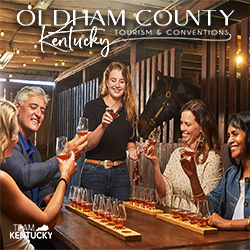
Courtesy Ky. Dept. of Tourism
Waveland State Historic Site
Lexington, Kentucky
Waveland, a classic Greek Revival structure with five large Ionic columns at its entrance, was built in 1848 by Joseph Bryan. Bryan replaced the original stone house built by his father, Daniel Boone Bryan, a nephew and namesake of the famous Kentucky pioneer, on a 2,000-acre land grant.
“They were one of the first families in the area. The bricks were made here on the place, and the timber was cut from the forests on the property,” said Ron Bryant, the site manager.
Waveland was initially a hemp plantation. But after the Civil War, Joseph Henry Bryan, grandson of the founder, built Waveland into a premier trotting-horse farm with its own racetrack and grandstands. He lost the property in the 1890s due to his gambling debts.
Today, Waveland, part of the Kentucky parks system, depicts life on a Kentucky plantation during the 19th century.
“The furnishings include several pieces the Bryans actually used in the mansion in the 1840s,” said Bryant.
Guides, generally in period costumes, take visitors through five rooms on the first floor and two bedrooms on the second, one of which has a large collection of 19th-century toys.
“Everyone who comes to Waveland gets a view of what life was like for a wealthy Kentucky family from the 1840s to the 1870s,” said Bryant.
Bryant said that groups get a tour of not only the mansion but also the original two-story brick slave quarters on the 15-acre grounds. The tour includes the kitchen on the first floor and the slaves’ living area on the second floor. A new exhibit that opened last year in the building tells about Kentucky slavery and includes artifacts such as a set of manacles and a slave dress.
www.parks.ky.gov/parks/historicsites/waveland
Waverley Plantation
West Point, Mississippi
Waverley Mansion, 15 minutes from West Point in northeast Mississippi’s Clay County, is a striking example of antebellum elegance.
Built around 1852, the Greek Revival mansion is famous for its octagon-shaped cupola and its self-supporting curved stairway.
The plantation was an independent community complete with gardens, orchards and livestock. It maintained a brick kiln, a cotton gin, an icehouse.
English boxwoods at the mansion’s entrance were planted more than 150 years ago by the wife of the mansion’s builder.
After standing vacant for nearly 50 years, the mansion was purchased in 1962 by a Philadelphia couple, who restored the mansion and 40 surrounding acres to their previous glory.The fully furnished mansion, which has its original ornamental plaster and marble mantels, is open for tours year-round.
www.wpnet.org/waverley_mansion.htm









